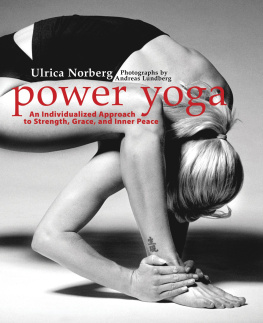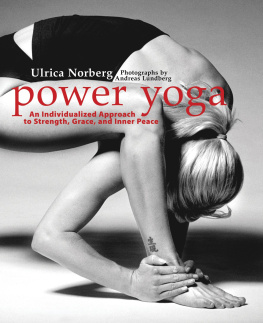Copyright 2016 by Ulrica Norberg
Foreword copyright 2016 by Kavi Yogiraj Alan Finger
Photographs by Sebastian Forsman
All rights reserved. No part of this book may be reproduced in any manner without the express written consent of the publisher, except in the case of brief excerpts in critical reviews or articles. All inquiries should be addressed to Skyhorse Publishing, 307 West 36th Street, 11th Floor, New York, NY 10018.
Skyhorse Publishing books may be purchased in bulk at special discounts for sales promotion, corporate gifts, fund-raising, or educational purposes. Special editions can also be created to specifications. For details, contact the Special Sales Department, Skyhorse Publishing, 307 West 36th Street, 11th Floor, New York, NY 10018or .
Skyhorse and Skyhorse Publishing are registered trademarks of Skyhorse Publishing, Inc., a Delaware corporation.
Visit our website at www.skyhorsepublishing.com.
10 9 8 7 6 5 4 3 2 1
Library of Congress Cataloging-in-Publication Data is available on file.
Cover design by Laura Klynstra
Cover photo by Sebastian Forsman
Print ISBN: 978-1-5107-0530-2
Ebook ISBN: 978-1-5107-0529-6
Printed in China
Important Note:
If you are unsure regarding your health status or if you have any imbalances you might think are affected through yoga practice, please seek advice from a doctor or professional physical therapist before embarking on this practice. This book is by no means a substitute to an experienced yoga teacher who can see your needs and can support you in your practice.
TABLE OF CONTENTS
INTRODUCTION
Life and the Importance of Pausing
CHAPTER ONE
The Power of Slowing Down
CHAPTER TWO
The Science Behind Yoga
CHAPTER THREE
Restorative Techniques
CHAPTER FOUR
Surrendering into Balance
CHAPTER FIVE
Meditations from the Mat


FOREWORD
By Kavi Yogiraj Alan Finger
I t is with utmost pleasure that I am recommending this book to whomever is interested in personal growth, therapeutics, spirituality, science, yoga, meditation, or just in enhancing ones health.
There are so many books on yoga out there today, but few are written by someone like Ulrica who fully understands the depths and science of yoga, and who is equally well-trained academically.
This book is one of a kindgenerous, sincere, and wise, like Ulrica. It shows the importance of pausing and reflection and how we can integrate this art into our living. Ulrica also focuses on the intimate relationship between science and spirituality and what this beautiful connection can do for us as individuals as well for humanity as a whole.
One of the great teachings of yoga is called Kaivalya, which in Sanskrit means space from the mind. When you are not engrossed in your mind, you dont react to things, but instead you respond . One responds from the spirit, the source of inspiration, insight, creativity, and intuition, which are things that all humans need in this fast-paced world we live in.
The Ishta approachdeveloped by Mona Anand and Gina Menza, that Ulrica describes in this bookis designed to help you to develop that space in your mind, and the ability to enjoy longer periods of meditation. Meditation is the process of allowing your brain to become accustomed to stillness, which gives us the ability to gain perspective and distance, which we need in order to balance ourselves better.
It has been a privilege to be Ulricas mentor and teacher for eight years now, and to witness her amazing growth as a yogi. When she came to me, she had already mastered so much, so I went on to teach her the science of the subtle body, which Ulrica has incorporated partly into this book.
Ulrica stands solid in the yogic tradition, honoring anyone and everything she is a part of, and she is established in the academic worlds and areas of creativity and human sciences. I am proud to have initiated her into the ISHTA lineage as a Yogiraj, Yoga Master.
Our modern society needs to de-stress and calm down mentally so that we can see life with a clearer perspective. I am confident that this book will help many to achieve that and help unlock ones hidden treasures.
Alan Finger
New York City
February 2016




INTRODUCTION
Life and the Importance of Pausing
The present moment is filled with joy and happiness. If you are attentive, you will see it.
Thich Nhat Hanh
W hen one starts to reflect upon life and its measures, one marvels at the vastness of the whole thing. Life is fascinating, scary, beautiful, mysterious, and yet very relevant because it involves you and me and all living things in this universe. It is what connects us. Right here, right now.
Life contains and involves everything. This everything possesses many definitions. Life refers to a collective phenomenon and to the ability of an individual organism to metabolize and grow, and life refers to the history of activities that an organism undertakes. Life is also the sum of our living: ones experiences, discoveries, movement, and moments. Einstein once said that life is like riding a bicycle. In order to keep our balance, we have to keep moving, keep living.
A Buddhist thought around this is that life is movement, or change. The more fluid you are, moving with movement, the more alive you become. In yoga, life is what is experienced. Its philosophy also claims that life is being expressed in our cellular structure and it is linked together by life force: prana .
PRANA
We want our life force to flow uninterruptedly within our channels in order to be in homeostasis, balance. Over thousands of years, yogis have researched through their own and others practices that the body, mind, and spirit work in correlation and in connection to one another. If our circulation of life gets stuck somewhere due to too much stress and tension, then what we need to do is to unlock the blockages of prana and homeostasis will return.
In yoga, we work with tension and through different techniques we wish to move deeper into it, step by step, day by day, practicing again and again, until we reach its core. Then we stay with it and use releasing techniques like slow poses, visualization, breath, and silence in order for the tension to resolve. We need to slow things down in the core of tension so the bodily systems that have perhaps been drained of energy can take some time to recover new energy, and slowly the stress and tension release their grip.
Take a sponge as an example. We leave it close to water and it will slowly start to move toward the liquid in order to absorb it. That is the code, the programming of that texture. We can look at our own systems in a similar way. The more we use them the wrong way, the more we take away from their binary code intelligence.

















